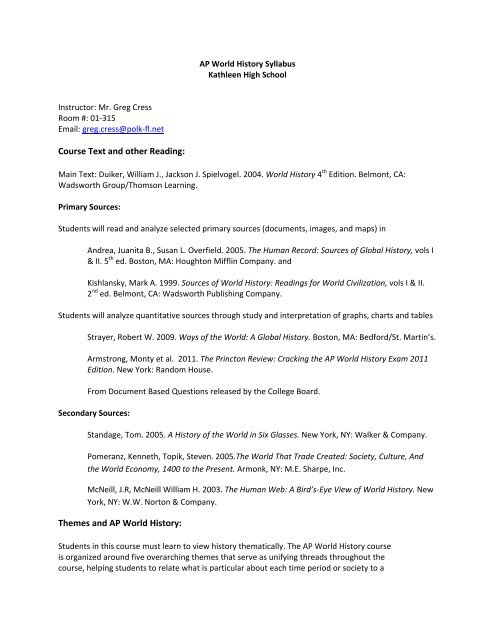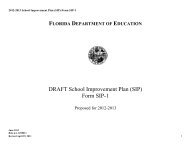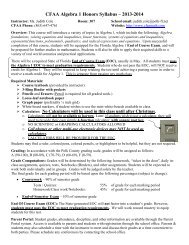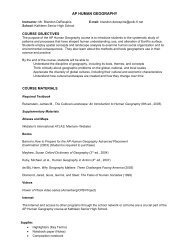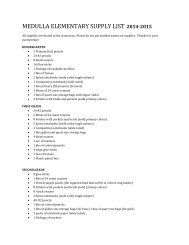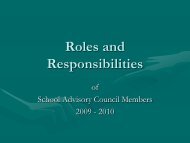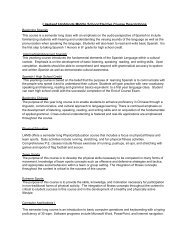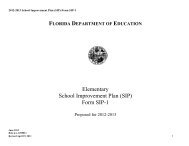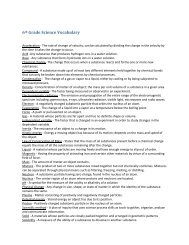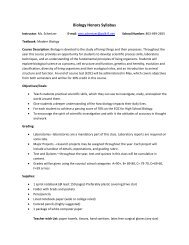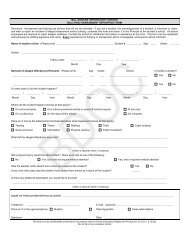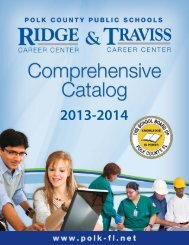AP World History - Polk County School District
AP World History - Polk County School District
AP World History - Polk County School District
- No tags were found...
Create successful ePaper yourself
Turn your PDF publications into a flip-book with our unique Google optimized e-Paper software.
<strong>AP</strong> <strong>World</strong> <strong>History</strong> SyllabusKathleen High <strong>School</strong>Instructor: Mr. Greg CressRoom #: 01‐315Email: greg.cress@polk‐fl.netCourse Text and other Reading:Main Text: Duiker, William J., Jackson J. Spielvogel. 2004. <strong>World</strong> <strong>History</strong> 4 th Edition. Belmont, CA:Wadsworth Group/Thomson Learning.Primary Sources:Students will read and analyze selected primary sources (documents, images, and maps) inAndrea, Juanita B., Susan L. Overfield. 2005. The Human Record: Sources of Global <strong>History</strong>, vols I& II. 5 th ed. Boston, MA: Houghton Mifflin Company. andKishlansky, Mark A. 1999. Sources of <strong>World</strong> <strong>History</strong>: Readings for <strong>World</strong> Civilization, vols I & II.2 nd ed. Belmont, CA: Wadsworth Publishing Company.Students will analyze quantitative sources through study and interpretation of graphs, charts and tablesStrayer, Robert W. 2009. Ways of the <strong>World</strong>: A Global <strong>History</strong>. Boston, MA: Bedford/St. Martin’s.Armstrong, Monty et al. 2011. The Princton Review: Cracking the <strong>AP</strong> <strong>World</strong> <strong>History</strong> Exam 2011Edition. New York: Random House.From Document Based Questions released by the College Board.Secondary Sources:Standage, Tom. 2005. A <strong>History</strong> of the <strong>World</strong> in Six Glasses. New York, NY: Walker & Company.Pomeranz, Kenneth, Topik, Steven. 2005.The <strong>World</strong> That Trade Created: Society, Culture, Andthe <strong>World</strong> Economy, 1400 to the Present. Armonk, NY: M.E. Sharpe, Inc.McNeill, J.R, McNeill William H. 2003. The Human Web: A Bird’s‐Eye View of <strong>World</strong> <strong>History</strong>. NewYork, NY: W.W. Norton & Company.Themes and <strong>AP</strong> <strong>World</strong> <strong>History</strong>:Students in this course must learn to view history thematically. The <strong>AP</strong> <strong>World</strong> <strong>History</strong> courseis organized around five overarching themes that serve as unifying threads throughout thecourse, helping students to relate what is particular about each time period or society to a
“big picture” of history. The themes also provide a way to organize comparisons and analyzechange and continuity over time. Consequently, virtually all study of history in this class willbe tied back to these themes by utilizing a “SPICE” acronym.Social‐‐Development and transformation of social structures• Gender roles and relations• Family and kinship• Racial and ethnic constructions• Social and economic classesPolitical‐‐State‐building, expansion, and conflict• Political structures and forms of governance• Empires• Nations and nationalism• Revolts and revolutions• Regional, trans‐regional, and global structures and organizationsInteraction between humans and the environment• Demography and disease• Migration• Patterns of settlement• TechnologyCultural‐‐Development and interaction of cultures• Religions• Belief systems, philosophies, and ideologies• Science and technology• The arts and architectureEconomic‐‐Creation, expansion, and interaction of economic systems• Agricultural and pastoral production• Trade and commerce• Labor systems• Industrialization• Capitalism and socialismCourse ScheduleUnit 1 To 600 BCE: Technological and Environmental TransformationsKey Concepts:• Big Geography and the Peopling of the Earth• Neolithic Revolution and Early Agricultural Societies• Development and Interactions of Early Agricultural, Pastoral, and Urban SocietiesTopics for Overview include:• Prehistoric Societies• From Foraging to Agricultural and Pastoral Societies• Early Civilizations: Middle East, South Asia, East Asia, the Americas, Africa, and Oceania
Special Focus:Issues Regarding the Use of the Concept of CivilizationActivities & Skill Development• Students will identify and analyze the causes and consequences of the NeolithicRevolution in the major river valleys as well as in Sub‐Saharan Africa and Papua NewGuinea• Class DiscussionHow were gender roles changed by the Neolithic Revolution?• Collaborative Group‐JigsawStudents will analyze how geography affected the development of political, social,economic, and belief systems in the earliest civilizations in:MesopotamiaEgyptSouth AsiaEast AsiaMesoamericaAndesEach group will examine a different civilization then compare findings with a new group where eachstudent examined a different civilization.• Parallel Reading‐‐Students will read Ch. 1‐ 3 of The Human Web and evaluate the authors’ perspectiveon the process of humanity from apprenticeship to civilization in the old world through the existence ofa very loose knit global web.Students will read Ch 1 ‐2 of A <strong>History</strong> of the <strong>World</strong> in Six Glasses and evaluate the author’s perspectiveon the civilizing qualities of beer on mankind and the relationship beer played in development ofwriting, commerce, and health.Unit 2 600 BCE‐600 CE: Organization and Reorganization of Human SocietiesKey Concepts:• Development and Codification of Religious and Cultural Traditions• Development of States and Empires• Emergence of Transregional Networks of Communication and ExchangeTopics for Overview include:• Classical Civilizations• Major Belief Systems: Religion and Philosophy• Early Trading NetworksSpecial Focus:• <strong>World</strong> ReligionsAnimism focusing on Australasia and Sub‐Saharan AfricaJudaism and ChristianityHinduism and BuddhismDaoism and Confucianism• Developments in Mesoamerica and Andean South America: Moche and Maya
Bantu Migration and its Impact in Sub‐Saharan AfricaTransregional Trade: the Silk Road and the Indian OceanDevelopments in China—development of imperial structure and Confucian societyActivities & Skill Development:• Writing a Comparison Essay ‐ Methods of political control in the Classical period,student choice of two Han China, Mauryan/Gupta India, Imperial Rome, Persian Empire• Writing a Change and Continuity over Time Essay ‐ Political and Cultural Changesin the Late Classical Period, students choose China, India, or Rome• Students will evaluate the causes and consequences of the decline of the Han, Roman,and Gupta empires• Students will map the changes and continuities in long‐distance trade networks in theEastern Hemisphere: Eurasian Silk Roads, Trans‐Saharan caravan routes, Indian Oceansea lanes, and Mediterranean sea lanes• Group PresentationsEach group will research and present a major world religion/belief system examining:originbeliefs and practicesdiffusion• After reading chapters 3 ‐4 of A <strong>History</strong> of the <strong>World</strong> in Six Glasses, students will assess the relationshipbetween wine and empire, medicine, and religion with a critical evaluation of the Islamic prohibition onwine.• Parallel Reading‐‐Students will read Ch. 3 of and trace the development of civilization in each regionutilizing a linear thematic organizer for note‐taking and a circular organizer for the big picture. Studentswill also evaluate the periodization in Ch.3—i.e. the use of 200 CE as a break as opposed to theperiodization of the course curriculumUnit 3 600‐1450: Regional and Transregional InteractionsKey Concepts:• Expansion and Intensification of Communication and Exchange Networks• Continuity and Innovation of State Forms and Their Interactions• Increased Economic Productive Capacity and Its ConsequencesTopics for Overview include:• Byzantine Empire, Dar‐al Islam, & Germanic Europe• Crusades• Sui, Tang, Song, and Ming empires• Delhi Sultanate• The Americas• The Turkish Empires• Italian city‐states• Kingdoms & Empires in Africa• The Mongol Khanates• Trading Networks in the Post‐Classical <strong>World</strong>Special Focus:• Islam and the establishment of empire
• Polynesian Migrations• Empires in the Americas: Aztecs and Inca• Expansion of Trade in the Indian Ocean—the Swahili Coast of East AfricaActivities & Skill Development:• Writing a Comparison EssayComparing the level of technological achievement including production of goods500‐1000• Student choice: Middle East, South Asia, East Asia, Eastern Europe• Students will evaluate the causes and consequences of the spread of Islamic empires• Students will compare the Polynesian and Viking migrations• Writing a Comparison EssayEffects of Mongol conquest and rule, students choose two: Russia, China, MiddleEast• Class DebatesTopic—Were the economic causes of the voyages of the Ming navy in the first halfof the 15th century the main reason for their limited use?Topic—Were the tributary and labor obligations in the Aztec and Inca empires moreeffective than similar obligations in the Eastern Hemisphere?• Writing a Change and Continuity over Time EssayChanges and Continuities in patterns of interactions along the Silk Roads 200 BCE‐1450 CE• Parallel Reading‐‐Students will read Ch. 4 & 5 of The Human Web and trace the development ofcivilization in each region utilizing a linear thematic organizer for note‐taking and a circular organizer forthe big picture. Students will also evaluate the periodization in the book compared to that of theperiodization in the course curriculum ‐ Why 200‐1000 CE and 1000‐1500 CE instead of 600‐1450? Inwhat regions does each work best? Why? In what areas does each present a problem? Why?Unit 4: 1450‐1750: Global InteractionsKey Concepts:• Globalizing Networks of Communication and Exchange• New Forms of Social Organization and Modes of Production• State Consolidation and Imperial ExpansionTopics for Overview include:Bringing the Eastern and Western Hemispheres Together into One Web• Ming and Qing Rule in China• Japanese Shogunates• The Trading Networks of the Indian Ocean• Effects of the Continued Spread of Belief SystemsSpecial Focus:• Three Islamic Empires: Ottoman, Safavid, Mughal• Cross‐Cultural Interaction: the Columbian Exchange• The Atlantic Slave Trade• Changes in Western Europe—roots of the “Rise of the West”
Activities & Skill Development• Students will evaluate the causes and consequences of European maritime expansionincluding the development of armed trade using guns and cannons• Student projectEach student will apply techniques used by art historians to examine visual displaysof power in one of the land or sea based empires that developed in this time period• Writing a Comparison EssayProcesses of empire building, students compare Spanish Empire to either theOttoman or Russian empires• Writing a Change and Continuity over Time EssayChanges and Continuities in trade and commerce in the Indian Ocean Basin 600‐1750• Parallel Reading‐‐Students will read Ch. 6 of The Human Web and trace the development of civilizationin each region utilizing a linear thematic organizer for note‐taking and a circular organizer for the bigpicture. Students will also consider the question of periodization: 1750 or 1800? Students will evaluatethe author’s perspective on the changing dynamics of the global web from a metropolitan web to acosmopolitan web.Students will read the following essays from chapter 1 of The <strong>World</strong> That Trade Created , 1.1 “The FujianTrade Diaspora,” 1.2 “The Chinese Tribute System,” and 1.4 “When Asia Was the <strong>World</strong> Economy,” anddraw conclusions as to why the Asian world fell prey to the encroachments of Islamic and later Europeandomination.Students will read chapters 5 – 6 of A <strong>History</strong> of the <strong>World</strong> in Six Glasses and discuss the connectionsbetween spirits and colonization as well as describe the effect that coffee played on the global balanceof power in terms of commerce.Unit 5 1750‐1900: Industrialization and Global IntegrationKey Concepts:• Industrialization and Global Capitalism• Imperialism and Nation‐State Formation• Nationalism, Revolution and Reform• Global MigrationTopics for Overview include:• The Age of Revolutions:English Revolutions, Scientific Revolution & Enlightenment,American Revolution, French Revolution and its fallout in Europe, Haitian &Latin American Revolutions• Global Transformations:Demographic Changes, the End of the Atlantic Slave Trade, Industrial Revolutionand Its Impact, Rise of Nationalism, Imperialism and its Impact on the <strong>World</strong>Special Focus:• Decline of Imperial China and the Rise of Imperial Japan• 19th Century Imperialism: Sub‐Saharan Africa, South and Southeast Asia• Comparing the French and Latin American Revolutions• Changes in Production in Europe and the Global Impact of those Changes
Activities include:• Writing a Comparison EssayComparing the roles of Women from 1750 to 1900—East Asia, Western Europe,South Asia, Middle East• Students will write a change and continuity over time essay evaluating changes inproduction of goods from 1000 to 1900 in the Eastern Hemisphere• Parallel Reading‐‐Students will read Ch. 7 of The Human Web and trace the development of civilizationin each region utilizing a linear thematic organizer for note‐taking and a circular organizer for the bigpicture. Students will also consider the question of periodization: 1900 or 1914? Students must defendor refute the author’s conclusions regarding the vast changes brought about during the years 1750 –1914 that the” growing inequality of wealth and power required that the less well off remain inignorance, that they meekly accept their fate, or that they be bludgeoned into accepting it.”Students will read chapters 9 – 10 of A <strong>History</strong> of the <strong>World</strong> in Six Glasses and discuss the integral roletea and the industrial revolution, politics, and Britain’s rule over India.• Students will analyze five political cartoons about European imperial expansion inAsia and Africa to identify how nationalism and the Industrial Revolution served asmotivating factors in empire building in this time period• Students will analyze tables showing increased urbanization in various parts of theworld to consider connections between urbanization and industrialization.• Utilizing a series of documents, maps and charts in the released DBQ about indenturedservitude on in the 19th and 20th centuries, students will assess the connectionsbetween abolition of plantation slavery and increased migrations from Asian countriesto the AmericasUnit 6 1900‐present: Accelerating Global Change and RealignmentsKey Concepts:• Science and the Environment• Global Conflicts and Their Consequences• New Conceptualizations of Global Economy and CultureTopics for Overview include:• Crisis and Conflict in the Early 20th Century:Anti‐Imperial Movements, <strong>World</strong> War I, Russian, Chinese and Mexican Revolutions,Depression, Rise of Militaristic and Fascist Societies, <strong>World</strong> War II• Internationalization:Decolonization, the Cold War <strong>World</strong>, International Organizations, the Post‐Cold War<strong>World</strong>, GlobalizationSpecial Focus:• <strong>World</strong> War I and <strong>World</strong> War II: Global Causes and Consequences• Activity—Skill DevelopmentStudents will identify and analyze the causes and consequences of the globaleconomic crisis in the 1930s• Development of Communism in China, Russia, and Cuba• Responses to Western Involvement in Sub‐Saharan Africa: Imperialism, the Cold War,and International Organizations
Activities include:• Writing a Comparison Essay Comparing the political goals and social effects ofrevolution in: China, Russia, Mexico: Students choose two• Writing a Change and Continuity over Time Essay: Changes and Continuities in theformation of national identities 1900‐present. Students choose from among the followingregions: Middle East, South Asia, or Latin America• Students debate the benefits and negative consequences of the rapid advances inscience during the 20th and early 21st centuries• Students trace the development of one form of popular culture in the 20th century andpresent a graphic or visual display of their research to the class• Parallel Reading‐‐Students will read Ch.8 of The Human Web and consider the following: Why does thischapter reach back to 1890? Students will read chapters 11 – 12 of A <strong>History</strong> of the <strong>World</strong> in Six Glassesand evaluate the author’s perspective on “globalization in a bottle.”Essay WritingThroughout the course students will be required to write essays in class demonstrating theirmastery of content as well as their ability to develop coherent written arguments that havea thesis supported by relevant historical evidence. During first semester the focus will be onthe development of essay writing skills via time spent on essay writing workshops utilizingthe following format in essay development:Introductory Paragraph—3 to 4 sentences, ending with thesis statementThesis Statement‐what does it need to include?• time period• region(s)• the answer to the promptOrganization of Body Paragraphs—• Topic Sentence—this can be general since the thesis contains specificity• General Assertion—identifies one aspect of thesis (i.e. a change, a difference, etc.)• Support/evidence/examples—Be specific!• Analysis‐explain cause and/or effect• General Assertion—identifies one aspect of thesis (i.e. a change, a difference, etc.)• Support/evidence/examples—Be specific!• Analysis‐explain cause and/or effect• Repeat format as necessary• Concluding SentenceConcluding Paragraph• 3‐4 sentences• Start by restating (a rephrased) thesis in its entiretyEssay writing workshops will include group discussion utilizing example essay, self‐evaluation,and peer evaluation
Primary Source Document Notebook AssignmentThroughout the first semester students will have the opportunity to develop and enhancetheir skills at interpreting, summarizing, and analyzing primary source material includingdocuments, maps, charts & graphs, and visuals. The ability to comprehend and analyzeprimary sources will first be practiced in large group and small group discussion then inindividual primary source assignments that students will summarize and analyze and placein a Primary Source Notebook which will be turned in once each 6‐week grading period.Directions for Primary Source Write‐ups: [CR8]READ the document or STUDY the data or visual. Then write a summary (the MAIN pointor points) of the document. This summary should be brief paragraph and should highlightthe main gist of the source in the students own words. The analysis of the source will becontained in a separate paragraph and should include:• Historical Context‐‐where the source fits in the framework of history.• <strong>AP</strong> themes that the source addresses. Students will be required to identify where andexplain how the source addresses that theme. Students will identify as many themes asthey can find but then evaluate those themes and only include what they consider to bethe two most prominent themes. Point of View—here students must consider point of view of theauthor, the type of document and/or tone of the source, purpose and/or intended audience.This skill will be developed throughout much of first semester using class discussion andpartner discussions with the end goal that all students will understand how to analyze theoverall point of view of a source and be able to discuss how that point of view may affect thesource by the end of first semester.Some of the sources used for these exercises include:• Tacitus from Germania• Female figure from Catalhuyuk (visual)• Graph—world population 3000 BCE ‐1500 CE• The Code of Hammurabi• “Be a Scribe”• The Writings of Han Fei• Asoka, Rock and Pillar Edicts• Pericles Funeral Oration• Shi Huangdi’s Terracotta Army (visual)• Fu Xuan, How Sad it is to be a Woman• Live, <strong>History</strong> of Rome• Procopius from On the Buildings and The Secret <strong>History</strong>• Shield Jaguar and lady Xoc: A Royal Couple of Yaxchilan (visual)• Xuanzang, Record of the Western Region• Einhard, The Life of Charlemagne• Ibn Battuta, Travels in Asia and Africa• Kitabatake Chikafusa, The Chronicle of the Direct Descent of Gods and Sovereigns• The Chronicle of Novgorod• William of Rubruck, Journey to the Land of the Mongols• <strong>World</strong> Population Growth 1000‐2000 (graph)• Jahangir, Memoirs
Students will continue to practice their skills at interpreting and analyzing primary sourcesby using them to synthesize information in DBQ essays. After introducing the concept ofthe DBQ to the students via roundtable discussion and practice writing of thesis statementsand individual body paragraphs, students will write 4‐6 DBQ essays that include written andvisual sources as well as map, charts, and graphs.GradingGrade Scale100 – 90 = A, 89 ‐ 80 = B, 79 – 70 = C, 69 – 60 = D, Below 60 = FGeneral Grade DefinitionsABOVE and BEYOND AVERAGEA = Strong scholarship, work significantly exceeds the requirements of the instructor, and demonstratesindependent thought and resourcefulness. Work is neat, organized, and free from spelling errors and ontime. Work shows significant increase development of the student, and the work, if shared, enhancesthe group’s learning.BEYOND AVERAGEB = Accurate and complete scholarship that goes beyond the requirements of the instructor, anddemonstrates above‐average achievement. Work is neat, organized, and free from spelling errors andon time. Work shows some increased development of the student, and the work, if shared, is beneficialto the group’s learning.AVERAGEC = Scholarship meets the minimum requirements of the instructor, and demonstrates littleindependent thought or may simply parrot the text. Work is neat, but may not be well organized andmay contain spelling errors, and may possibly be late. Work shows little increased development of thestudent, if any. The work, if shared, is marginally beneficial to the group’s learning.BELOW AVERAGED = Scholarship does not meet the requirements of the instructor, and demonstrates no independentthought and may be copied from another source, or paraphrased. Work may or may not be neatly doneand well organized. The work may contain spelling errors, and may be late. Work shows no evidence ofincreasing the development of the student. The work, if shared, has little, or no, benefit for the group’slearning.
SIGNIFICANTLY BELOW AVERAGEF = Scholarship does not meet the minimum requirements of the instructor or the assignment. The workshows no evidence of independent thought, was copied from another source, or was paraphrased. Thework may be late, or not turned in at all. If turned in, the work may not be neat, may contain spellingerrors, and may be incomplete. If shared, the work is not beneficial to the group’s learning.Grade WeightsGrades in this course are weighted as follows:1. Unit Tests = 35%2. Homework and skills lessons = 10%3. Reading Quizzes = 15%4. Essays (average of all) = 20%5. Class notebook and class binder = 10%6. Class participation and conduct = 10 %Semester exams:1. January: comprehensive for the semester.2. June: The final exam is a district mandate and will comprehensive nature.Students WILL have some type of assignment for this class each day, including weekends and nonclassdays. It may be working on their notebook, doing some assigned reading, reviewing for a test, or itmay be a more formal assignment. As a general rule of thumb, college classes demand two to threehours of work outside class for each hour spent in the classroom. You should expect that your work isgoing to take about one hour each day (7‐10 hours per week, every week).Assignments and TestsAssignments1. Homework is due at the beginning of class, so do not plan to finish it during class. If youmiss class because you are late to school, then it is your responsibility to give it to me
efore the end of the day. If you miss class because you are being dismissed early, thenit is your responsibility to give me the assignment(s) before you leave.2. Assignment due dates are listed in the assignment calendar. Late assignments aresubject to a sliding scale, 20% the first day, an additional 20% the second day, anadditional 20% the third day, an automatic zero (0) after the fourth day without achance to recover the grade. You know well in advance when an assignment is due soplan accordingly.3. Homework assignments are to be written or typed. If written, all assignments are to bewritten on white lined paper (8 ½ x 11), using blue or black ink only, with your name,date and section in the upper right corner. Use filler paper as these assignments will beadded to your portfolio notebook. Take pride in your work. I will not read assignmentswritten in orange, pastel colors, or any other strangely colored inks.Tests and Reading Quizzes1. Test dates are listed in the assignment calendar. Reading quizzes are not announced,but are given at one or two times each week at a minimum. Plan your studyingaccordingly.2. The ink rules from above apply to tests. Reading quizzes are generally multiple choice.3. Tests may be made up only if you have an excused absence. Make‐up tests are given at adate and time of my choosing, but within one week of the original test date. This is theONLY opportunity for a make‐up test.4. You may be excused by me from taking a scheduled test IF you have been absent two ormore consecutive days before the test. Cutting class, late to school, early dismissals donot count as an absence from school. Excused absences from school will be allowed anequal number of days in which to make up any assigned work.5. Make‐up quizzes are not given. The quiz average will be computed on the number ofquizzes actually taken over the quarter. Quizzes missed because of unexcused tardinesswill be scored as a zero.Classroom Conduct and Class ParticipationStudents are expected to come to class on time, with all necessary materials, and preparedto work. “On time” means that all students are in their seats and ready to begin the day’swork when the bell rings. As a standard rule, students are not allowed to leave theclassroom during class without a hall pass, and the hall pass is only for emergencies. I expect


